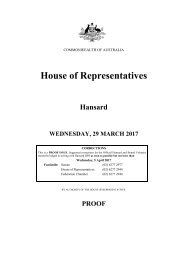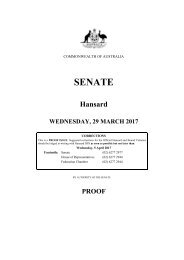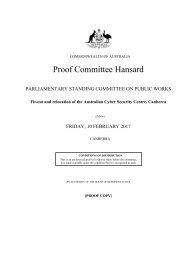SENATE
2e7N9wg
2e7N9wg
You also want an ePaper? Increase the reach of your titles
YUMPU automatically turns print PDFs into web optimized ePapers that Google loves.
Thursday, 13 October 2016 <strong>SENATE</strong> 87<br />
Defence should consider undertaking site testing … to determine if its facilities are contaminated by PFOS/PFOA and the<br />
extent of the contamination, and also consider establishing monitoring wells in areas where AFFF is repeatedly used and<br />
released …<br />
Defence should consider restricting the use of AFFF across its facilities in accordance to NICNAS recommendations.<br />
Defence should consider facilitating industry partnerships into researching the behaviour of AFFF mixtures and wastewater<br />
as they may occur in the Australian environment.<br />
AFFF waste-water management system should be designed to contain the most probable worst case AFFF discharge, to<br />
minimise the risk of any AFFF waste-water reaching watercourses, soil, or stormwater drains.<br />
The management of AFFF across Defence should meet the best practice methods used by others, as indicated in reports<br />
(manufacturer recommendations, US Defense, UK Defence, consultants’ reports) and in scientific literature.<br />
If open ponds are used to store AFFF waste-water they should be managed to restrict access by fauna (e.g. using netting or<br />
synthetic liners).<br />
It is imperative to contact the local waste authority to determine suitable waste disposal methods and if any pre-treatment<br />
or dilution is required.<br />
At a recent briefing I had with a defence spokesman, he admitted the existence of the report and stated that it was<br />
the catalyst for the actions that are taking place now—some 13 years later. This contradicts the information I<br />
received at another briefing in Newcastle, just after the election, by the then acting CEO of Hunter Water, Mr<br />
Jeromy Bath. He stated that Hunter Water knew of the foam contamination several years ago and had reported it<br />
to all of the appropriate authorities, believing they would immediately act on it. However, it was not acted on until<br />
about 18 months ago—well after authorities were alerted by Hunter Water. Mr Bath said that Hunter Water was<br />
very remorseful in not making the contamination issue public themselves when they first became aware of it.<br />
Further, Hunter Water has received $3.5 million to provide reticulated water to affected properties within the<br />
red zone. This work should be completed by April 2017 and under budget. In the meantime, bottled water is being<br />
provided at no cost. An issue that has arisen is that, when the houses of residents are connected to the reticulated<br />
water, some houses may not withstand the increased water pressure and the plumbing will need to be renewed to<br />
current standards. These supplementary works should also be part of any compensation package.<br />
Prior to the election, the Prime Minister promised $55 million Australia-wide for blood testing, which is<br />
voluntary, and an epidemiology study. The Defence Minister confirmed that commitment in an answer to a<br />
question I asked in the Senate recently. Unfortunately, the minister also confirmed in that answer that any<br />
compensation package or buyback will not be forthcoming until the results of that study are known. This could<br />
take several years. I have firmly suggested to the minister that this time frame is far too long and that, if the<br />
government does not act sooner, it may have another asbestos-type crisis on its hands in 20 years.<br />
More recently, enHealth has released new safety guidelines for PFOS and PFOA levels. The new tolerable<br />
daily intake levels for PFOS are 0.15 micrograms per kilogram per day, and 1.5 micrograms per kilogram per day<br />
for PFOA. These are 78 times higher than the levels deemed safe by the US EPA. EnHealth's drinking water<br />
guidelines are 0.5 micrograms per litre for PFOS and five micrograms per litre for PFOA—excessively above the<br />
0.07 micrograms per litre adopted by the US EPA. EnHealth's recommendations of these acceptable levels were<br />
endorsed by the Australian Health Protection Principal Committee, made up of chief health officers and a<br />
Department of Defence representative on 15 June this year. This commission is made up of members that held<br />
defence contracts worth many millions of dollars, and obviously there is a perceived conflict of interest. I am not<br />
suggesting in this chamber that there are any illegalities in the process. This decision reversed Australia's practice<br />
of adopting standards in line with those set by the US EPA. The US EPA drastically toughened its PFOS and<br />
PFOA guidelines, with stronger health warnings just three weeks before the Australian decision. This has raised<br />
suspicions in the community that the weaker safety standards are designed to reduce the number of people who<br />
will be eligible to be compensated and the quantum of payout.<br />
Senator BACK (Western Australia) (16:43): I rise in response to the general business notice of motion moved<br />
by Senator Burston. Can I congratulate Senator Burston on raising this matter and also for the terms of reference<br />
as he has presented them before the chamber. I come to this discussion on two bases. I come to it as a member of<br />
the committee which has been investigating this issue and, of course, as a participant in the three inquiries we<br />
have had—one in Canberra; one at Williamtown or in Newcastle, New South Wales; and in Oakey, Queensland. I<br />
also come to it from a background of having been, as you know, Mr Acting Deputy President Sterle, chief<br />
executive officer of the Bushfires Board of Western Australia—an agency that used firefighting foams.<br />
It might be of some interest to anybody listening to this discussion to know what the purpose of adding<br />
firefighting foam to water is for extinguishing fires. It is simply to create, at the microscopic level, a film around<br />
the material or the fuel that is to be burnt, and, in so doing, starve that fuel of oxygen.<br />
CHAMBER















